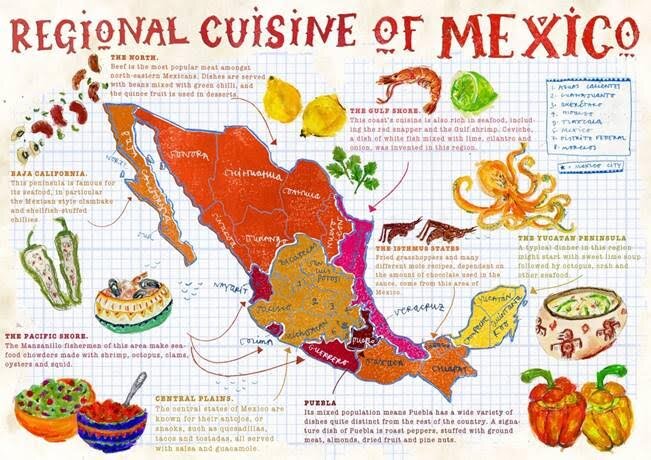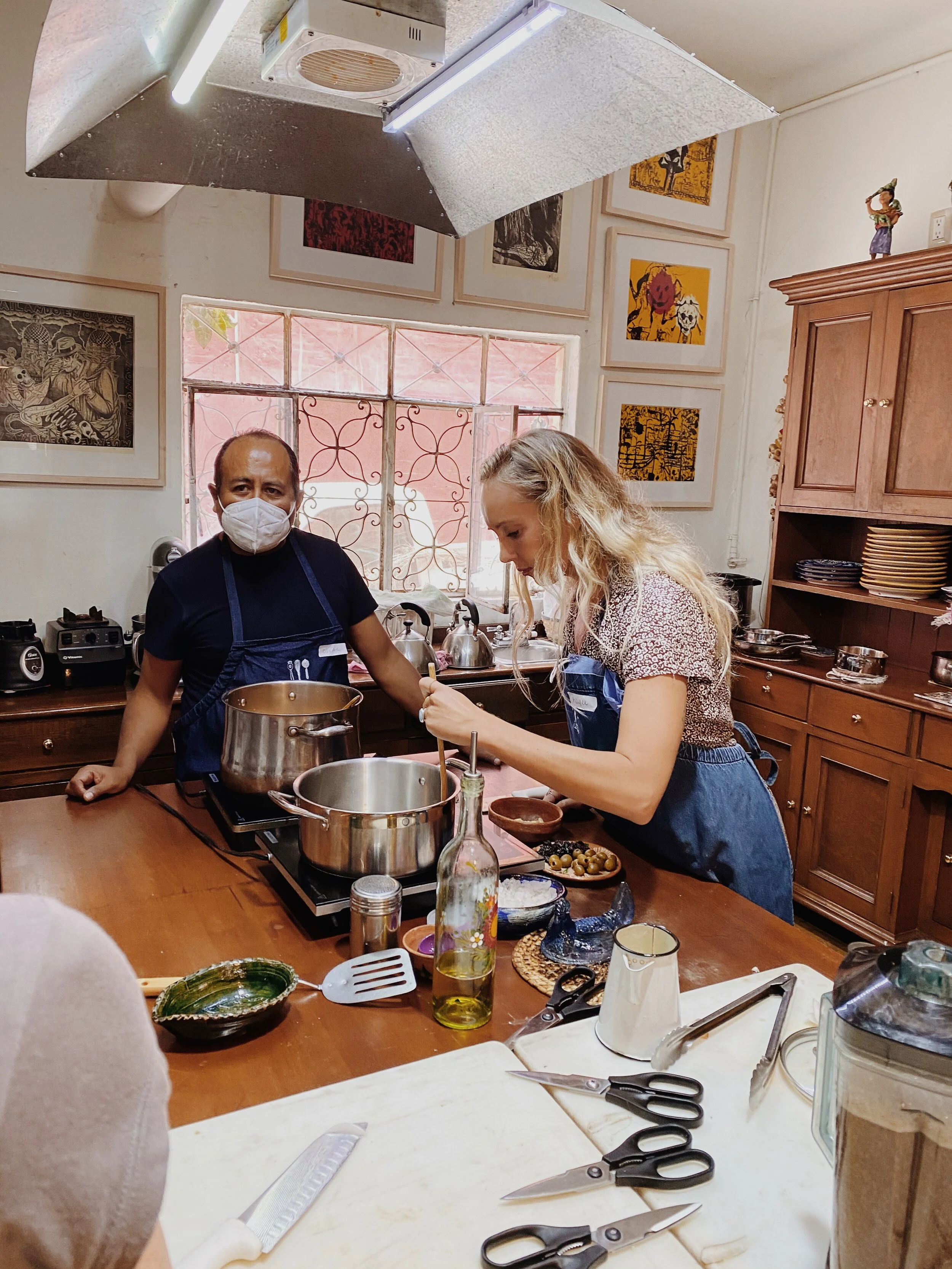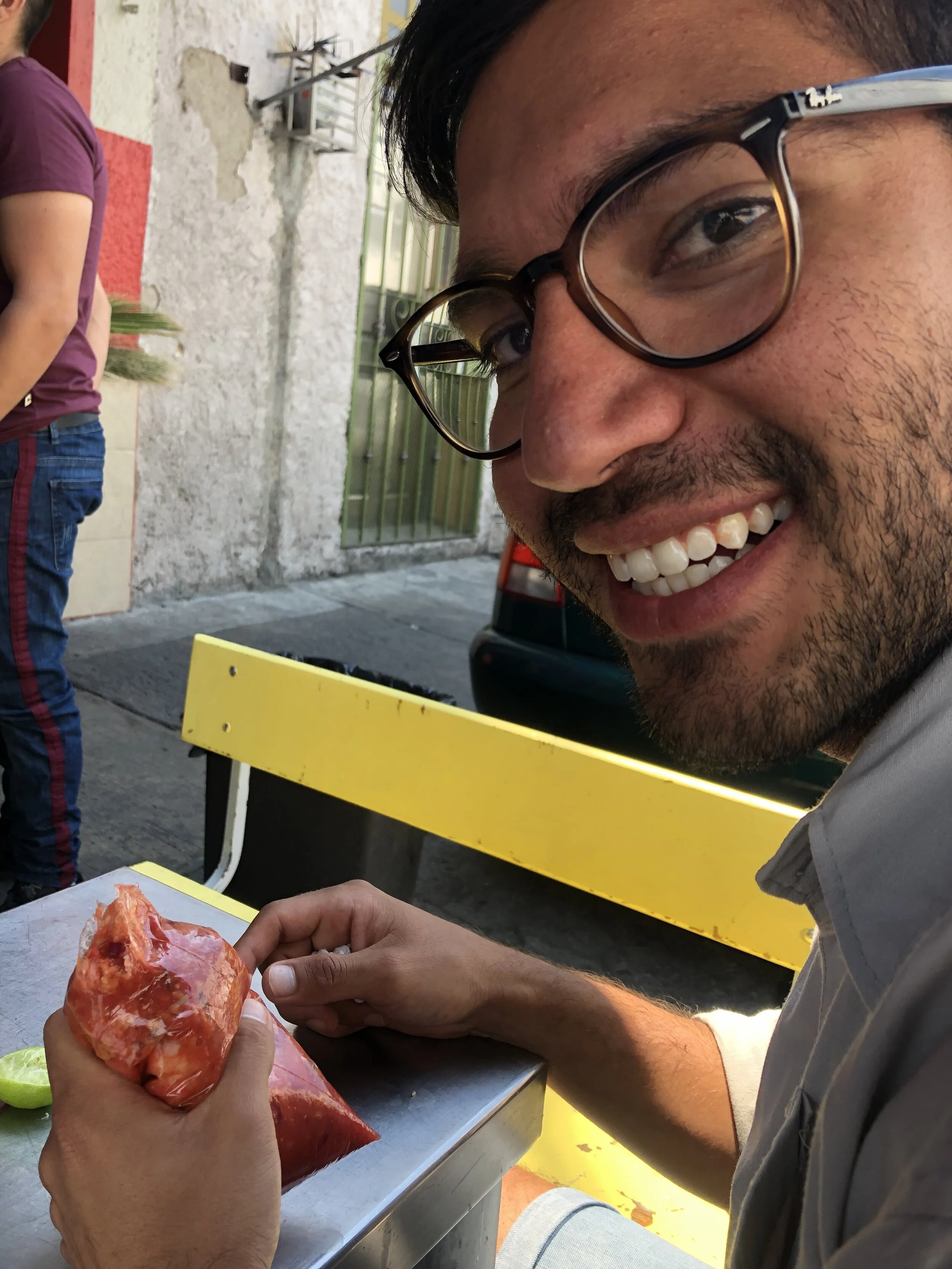The 7 Regions of Mexican Cuisine
Mexican food in the U.S. is usually synonymous with hard shell tacos and queso dip… however, these favorites are thanks to modern products of cultural integration. If you want real, authentic Mexican cuisine, there’s a wildly variable food landscape in Mexico that deserves more attention.
There are seven important regions that you should know if you’re interested in learning more about Mexican cuisine. Due to their geography and history, each region’s food has distinctive characteristics, varying in everything from staple crops to the spices used to season dishes. Learning about the food in different regions can help you get a better understanding of what Mexican cuisine is really comprised of and inspire you to go out and try something new!
Norteño (Northern Mexico)
A strong ranching tradition means that beef is king in Northern Mexico. Therefore, grilling is the popular method of cooking. Hearty staples like refried pinto beans, rice, and dried beef are also popular. The region’s variety of cheeses is also a result of the cattle industry. Wheat cultivation has led flour tortillas to be popular - In fact, the flour tortilla burrito was invented in Sonora.
Dishes to know:
Queso fresco
Machaca: Traditionally made by rehydrating dried beef.
Arrachera: Marinated skirt steak that is the origin of what we know as fajitas.
Cabrito: Roasted baby goat, especially popular in Monterrey.
Pan de semita
Capirotada: Similar to bread pudding, made with bolillo bread with sugar, spices, dried fruits, and nuts.
Bajacaliforniano
Known for its wines, as well as for popularizing fish tacos, Baja California comprises itself of two states. It is, predictably, a seafood-based cuisine (seafood-ized versions of norteño dishes, like skate machaca and abalone chorizo), but there are unexpected immigrant influences - Russian in Valle de Guadalupe, Chinese in Mexicali. Did we mention that the Caesar salad and margarita were invented here?
Dishes to know:
Caesar salad
Tacos of tempura fish and shrimp
Grilled lobster
Seafood cocktails
Ceviche
Margaritas
Oaxaqueño (Oaxaca)
This area in the South Pacific coast is geographically characterized by mountains and deep valleys. Oaxaca’s cuisine was less affected by the Spanish than other regions of Mexico, but was one of the first to experience the intermingling of food cultures with the Europeans. Today, much of the cooking culture maintains strong ties to the culinary traditions of the indigenous Mixtec and Zapotec people. Therefore, corn is a staple, tortillas are eaten at every meal, and black beans and chocolate are very popular.
Dishes to know:
Mole: There are seven varieties in total, including negro, amarillo, coloradito, manchamanteles, chichilo, rojo, verde.
Enfrijoladas
Queso Oaxaca: Adaptation of mozzarella.
Blandas: Corn tortillas.
Empanadas
Tamales
Tlayudas: The “Oaxacan pizza.”
Hoja santa: An essential herb used in cooking, sharing its flavor with anise, licorice, and tarragon.
Mezcal
Chiapas
Chiapan cuisine shares many similarities with Oaxacan cuisine, though there are some unique ingredients that distinguish the food from this area.
Corn is the dietary staple of the region, and common meats include beef, pork, and chicken. Vegetables are an essential component of even the meat and cheese dishes, especially squash, chayote, and carrots. The region is also known for its exceptionally spicy chiles.
Dishes to know:
Simojovel: Spicy chile.
Chipilín: Legume that is used for its leaves.
Pozol: Fermented corn drink that is usually flavored with chocolate.
Jaliscense
Jalisco’s state motto is “Jalisco es México,” presumably because it takes credit for many of the country’s most beloved traditions — mariachi, charrería (similar to rodeo), and tequila. Its cuisine reflects its rich natural and cultural resources with over 200 miles of coastline and most of Mexico’s largest freshwater lake (Lake Chapala), arid plans and snowy peaks, as well as Puerto Vallarta and Mexico’s second-largest city, Guadalajara.
Dishes to know:
Birria: Chile-stewed goat or lamb.
Torta ahogada: Soaked sandwich, often served in a plastic bag with sauces.
Caldo michi: Fish soup.
Pacholas: Ground meat and chile patty.
Pozole rojo
Yucateco (Yucatán)
The Yucatán Peninsula separates the Caribbean Sea from the Gulf of Mexico, and its geographical location has greatly influenced its cuisine. Yucatán food is different from that of much of Mexico thanks to a strong Mayan culinary tradition, as well as Caribbean, French, and Middle Eastern influences.
The spice achiote is a signature seasoning in the region, giving foods a distinctive reddish color. Habaneros are used as a condiment in many dishes, and tropical fruits like tamarind, plums, mamey, avocados, and bitter oranges are common. In coastal areas, seafood dishes are popular, such as raw conch marinated in lime juice, as well as local fish like Mero and esmedregal.
Dishes to know:
Poc-chuc: Grilled pork marinated with bitter organ juice, vinegar, and achiote paste.
Chiltomate: Habanero and tomato salsa.
Conchinita pibil: Pork dish from the Mayan culture.
Papadzules: Corn tortillas dipped in pumpkin seed sauce and filled with hard-boiled eggs.
Pozol
Achiote: Made from the annatto seed and has a nutmeg-like smell.
Kibbeh: Lebanese import.
Brazo de reina: Tamale stuffed with hard-boiled eggs.
Veracruzano (Veracruz)
Located on Mexico’s gulf coast, in Veracruz, Indigenous, Spanish and Afro-Caribbean influences dominate the area and the cuisine. The Europeans introduced spices like parsley, thyme, bay leaf, cilantro, and marjoram to the area, along with rice, citrus fruit, and pineapple. Olives, olive oil, and capers are also popular ingredients that were introduced by settlers from the Spanish Mediterranean. These ingredients are used alongside a variety of native tropical fruits, like papaya, mamey, and zapote, and vanilla, which is native to the area. Along with ingredients like peanuts, plantains, yucca, and sweet potatoes that were introduced as a result of the Caribbean slave trade, the region’s cuisine is richly varied. Due to its proximity to the coast, seafood is also prominent in the local food.
Dishes to know:
Huachinango: The most famous dish, prepared by baking a whole fish covered in a tomato sauce, seasoned with olives, garlic, capers, and spices.
Arroz a la tumbada: Paella-like, made with rice, shellfish, tomatoes, red peppers, parsley, oregano, and cilantro.
Pollo encacahuatado: Chicken with a tomato and peanut sauce.
Garnachas: Tortillas fried in oil, then dipped in salsa and topped with beans, onions, crema, and cheese.
Chileatole de pollo: Chicken stew.
Crema de palmitos: Creamy soup made by pureeing hearts of palm with chicken stock, green onion, and garlic.
Mole Xiqueño: Named after the city of Xico.
Poblano (Mexico City & Puebla)
Mexico City is an urban hub and center for migration whose cuisine is influenced by regions across the country, as well as many foreign countries. Street foods like tacos and tortas are very popular here. Some restaurants even focus on pre-Hispanic cuisine, like dishes with insects as the main protein component.
Puebla is located between Mexico City and Veracruz. Its cuisine is diverse, with a variety of indigenous and Spanish-influenced ingredients comprising its most famous dishes, cemitas, mole poblano, and chiles en nogada, the country’s national dish.
Dishes to know:
Barbacoa: Slow-cooked lamb over an open fire.
Cemitas: Meat milanesa, panela cheese, avocado, onions, pápalo, and salsa roja on sesame seed-covered bread.
Pápalo: An herb that tastes like a cross between arugula and cilantro.
Mole poblano: Mole made with over 20 different ingredients!
Chalupas
Chiles en nogada: Poblano chiles stuffed with picadillo (shredded meat and dried fruit), then topped with a creamy walnut sauce and pomegranate seeds.
Cecina: Marinated dried beef eaten raw or seasoned, thinly pounded pork that must be cooked before eating.




